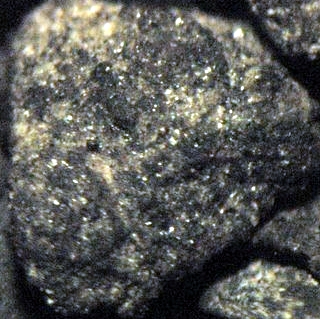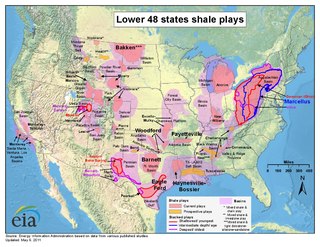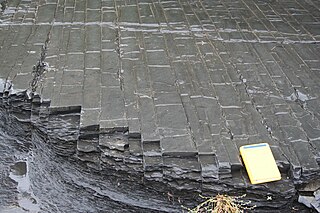
The Anadarko Basin is a geologic depositional and structural basin centered in the western part of the state of Oklahoma and the Texas Panhandle, and extending into southwestern Kansas and southeastern Colorado. The basin covers an area of 50,000 square miles (130,000 km2). By the end of the 20th Century, the Anadarko Basin was producing the largest amount of natural gas in the United States. Notable oil and gas fields within the basin include the Hugoton-Panhandle Gas Field, West Edmond Field, Union City Field and the Elk City Field. The basin is also the only commercial source of iodine in the United States and a major producer of helium.

The Piceance Basin is a geologic structural basin in northwestern Colorado, in the United States. It includes geologic formations from Cambrian to Holocene in age, but the thickest section is made up of rocks from the Cretaceous Period. The basin contains reserves of coal, natural gas, and oil shale. The name likely derives from the Shoshoni word /piasonittsi/ meaning “tall grass”.

The Williston Basin is a large intracratonic sedimentary basin in eastern Montana, western North Dakota, South Dakota, southern Saskatchewan, and south-western Manitoba that is known for its rich deposits of petroleum and potash. The basin is a geologic structural basin but not a topographic depression; it is transected by the Missouri River. The oval-shaped depression extends approximately 475 miles (764 km) north-south and 300 miles (480 km) east-west.

The Bakken Formation is a rock unit from the Late Devonian to Early Mississippian age occupying about 200,000 square miles (520,000 km2) of the subsurface of the Williston Basin, underlying parts of Montana, North Dakota, Saskatchewan and Manitoba. The formation was initially described by geologist J. W. Nordquist in 1953. The formation is entirely in the subsurface, and has no surface outcrop. It is named after Henry O. Bakken (1901–1982), a farmer in Tioga, North Dakota, who owned the land where the formation was initially discovered while drilling for oil.

The Madison Limestone is a thick sequence of mostly carbonate rocks of Mississippian age in the Rocky Mountain and Great Plains areas of the western United States. The rocks serve as an important aquifer as well as an oil reservoir in places. The Madison and its equivalent strata extend from the Black Hills of western South Dakota to western Montana and eastern Idaho, and from the Canada–United States border to western Colorado and the Grand Canyon of Arizona.
Enerplus Corporation is one of Canada’s largest independent oil and gas producers. The company holds oil and natural gas property interest in the United States and in western Canada, in the provinces of Alberta, British Columbia and Saskatchewan. The company is based out of Calgary, Alberta and trades on both the Toronto Stock Exchange and the New York Stock Exchange. It was Canada's first income trust.

Within the petroleum industry, proven crude oil reserves in the United States was 44.4 billion barrels (7.06×109 m3) of crude oil as of the end of 2021, excluding the Strategic Petroleum Reserve.

The Montney Formation is a stratigraphical unit of Lower Triassic age in the Western Canadian Sedimentary Basin in British Columbia and Alberta.

The Horn River Formation is a stratigraphic unit of Devonian age in the Western Canadian Sedimentary Basin.

Shale gas in the United States is an available source of unconventional natural gas. Led by new applications of hydraulic fracturing technology and horizontal drilling, development of new sources of shale gas has offset declines in production from conventional gas reservoirs, and has led to major increases in reserves of U.S. natural gas. Largely due to shale gas discoveries, estimated reserves of natural gas in the United States in 2008 were 35% higher than in 2006.

The Elk Point Group is a stratigraphic unit of Early to Middle Devonian age in the Western Canada and Williston sedimentary basins. It underlies a large area that extends from the southern boundary of the Northwest Territories in Canada to North Dakota in the United States. It has been subdivided into numerous formations, number of which host major petroleum and natural gas reservoirs.
The Duvernay Formation is a stratigraphical unit of Frasnian age in the Western Canadian Sedimentary Basin.

The Ellis Group is a stratigraphical unit of Bajocian-Oxfordian age in Alberta, Saskatchewan, Montana and Wyoming in the Western Canadian Sedimentary Basin. It takes the name from Fort Ellis, Montana, and was first described in outcrop in the Rocky Creek Canyon by A.C. Peale in 1893.
The Saskatchewan Group is a stratigraphical unit of Frasnian age in the Western Canadian Sedimentary Basin.

The Utica Shale is a stratigraphical unit of Upper Ordovician age in the Appalachian Basin. It underlies much of the northeastern United States and adjacent parts of Canada.

Continental Resources, Inc. is a petroleum and natural gas exploration and production company headquartered in Oklahoma City. The company was founded by Harold Hamm in 1967 at the age of 21 as Shelly Dean Oil Company, originally named for Hamm's two daughters. In 1990, Shelly Dean re-branded itself as Continental Resources. It primarily used hydraulic fracturing and directional drilling to produce from low permeability formations.

The Bazhenov Formation or Bazhenov Shale is a geological stratum in the West Siberian basin. It was formed from sediment deposited in a deep-water sea in Tithonian–early Berriasian time. The sea covered more than one million square kilometers in the central basin area. Highly organic-rich siliceous shales were deposited during this time in anoxic conditions on the sea bottom. The sea was connected to the world's oceans and contains trace minerals derived from dissolved minerals and organic materials similar to sapropel sediments in the Black Sea.
As of 2013 the Cline Shale, also referred to as the "Wolfcamp/Cline Shale", the "Lower Wolfcamp Shale", or the "Spraberry-Wolfcamp shale", or even the "Wolfberry", is a promising Pennsylvanian oil play east of Midland, Texas which underlies ten counties: Fisher, Nolan, Sterling, Coke, Glasscock, Tom Green, Howard, Mitchell, Borden and Scurry counties. Exploitation is projected to rely on hydraulic fracturing.
an organic rich shale, with Total Organic Content (TOC) of 1-8%, with silt and sand beds mixed in. It lies in a broad shelf, with minimal relief and has nice light oil of 38-42 gravity with excellent porosity of 6-12% in thickness varying 200 to 550 feet thick.
The Parshall Oil Field is an oil field producing from the Bakken Formation and Three Forks Formation near the town of Parshall, in Mountrail County, North Dakota. The field is in the Williston Basin. The field was discovered in 2006 by Michael Johnson and sold the play to EOG Resources, which drilled, and now operates, most of the wells. It was the discovery of the Parshall Field that was largely responsible for the North Dakota oil boom. Parshall's break-even price is at US$38/barrel, which is the lowest on the Bakken Formation; overall, Bakken's break-even point is of US$62/barrel.
The geology of North Dakota includes thick sequences oil and coal bearing sedimentary rocks formed in shallow seas in the Paleozoic and Mesozoic, as well as terrestrial deposits from the Cenozoic on top of ancient Precambrian crystalline basement rocks. The state has extensive oil and gas, sand and gravel, coal, groundwater and other natural resources.












